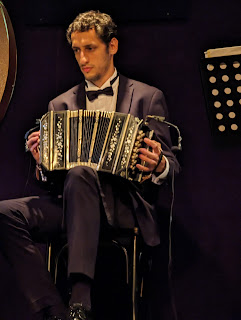On the passionate tango trail with magnificent dancers, musicians
- Christene Meyers

- Apr 3, 2024
- 4 min read
Updated: Oct 7

TANGO RISES FROM ITS HUMBLE BEGINNINGS TO INTERNATIONAL FAME POPULAR WITH RICH AND POOR, TOURISTS AND LOCALS
STORY By CHRISTENE MEYERS
PHOTOS By BRUCE KELLER


THIS WEEK, we offer a photo essay on the artful dance of tango. We took several hundred tango photos during seven recent performances in Argentina, Uruguay and on our ship, Celebrity Solstice. With so many good ones, we decided "more is more." We hope you'll enjoy.TANGO IS one of the most influential and famous dances of modern history, originating from the brothels and streets of 18th century Buenos Aires in Argentina and Montevideo in Uruguay. Both countries claim to have invented this favorite dance of European immigrants. Historians believe that tango evolved in the late 19th Century -- around 1880 -- in African-Argentine dance venues,

expanding to other venues where dancing also took place: bars, eateries and dance halls.
In Buenos Aires, tango shows the influence of Spain's national dance, flamenco. In Uruguay it blends African and Cuban influences, is less formal and invites audience participation at show's end. We saw the sensual, speedy milonga and habanera merging with tango in Uruguay. Some considered it a disreputable dance but it survives and is well loved today.
TANGO EVOLVED. By the early 1900s it was socially acceptable.

The first documented tango music was published in 1910; by 1915, tango was the craze in fashionable European circles.

Its popularity was evolving from the working classes to a dance form celebrated throughout the world, known both for its fine dancers and expert musicians. It has influenced the creation of many modern styles.

Early tango was spirited and lively, but by 1920 the music and lyrics had become intensely melancholy.
Tango steps evolved from early exuberance to smoother but still energetic ballroom steps and tempos.
MANY RECOGNIZE "Le Grand Tango," a spirited piece for cello and piano by Argentine composer Astor Piazzolla. The work expresses the vibrancy of nuevo tango --new tango -- a melding of modern tango trends with a nod to 18th century tango in Buenos Aires and Montevideo.


Tango has evolved from the favorite dance of European immigrants, former slaves, working and lower classes of people to an art form beloved by all classes. Its quick rise in popularity enabled this famous dance to expand out of South America, to Europe, North America and the rest of the world.
Keller and Cookie pose beside a tango tableau at a Montevideo tango show.
Fast, sexy footwork and quick, precise movements are tango hallmarks, here at Michelangelo. One is reminded of Barcelona's flamenco, because tango is influenced by that dance.
|
With its rich history, variety of styles, and undisputed appeal, tango remains one of the most popular dances in the world.
So who "invented" tango? The "credit war" continues in good natured fashion. Carlos Gardel (French born in 1890 as Charles Romuald Gardès) lived in both Argentina and Uruguay. Both countries claim this influential interpreter of their favorite dance form.
Our tour guide had an authentic pumpkin gourd cup for her mate, and a thermos of very hot water to refill the cup as she and the driver sipped. It's okay to share a straw, she said, and they did as we toured. |
UP NEXT: Another tradition -- mostly in Uruguay -- is the constant consumption of a bitter tea, Yerba mate, also known as mate. The herbal drink is served in a mug, with hot water from an accompanying thermos. While it's a traditional drink in Latin and South America, it is most popular in Uruguay, where it is carried around by nearly everyone in two containers -- the cup with a bag of the herbal tea ready to mix, and a thermos of hot water to keep the buzz going. The mate is made by steeping dried leaves from the yerba mate plant in the hot water. It is left to steep and can be served cold or hot. We were fascinated by the proliferation of the mate cup and thermos on tours, in parks, on streets and in airports and ferry stations. Remember to explore, learn and live and catch us weekly for a fresh spin on the arts, culture, performance, nature, family and more.






Comments